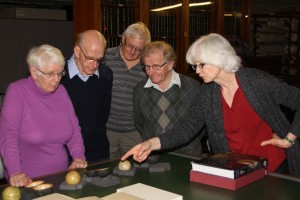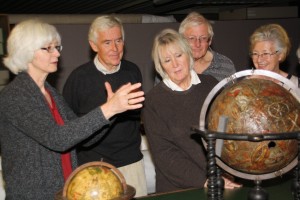October 25, 2013
Visit to the RMG LTE Store
Report by: Mike Dryland
The History Group was very fortunate to be offered a visit to the Museum’s LTE Store on October 25th. LTE is a secure storage site not normally open to the public. It holds most of the RMG’s collection of art, textiles, ceramics, and paper items including globes.
Our visit was hosted by Store Manager, Sarah Kmosena, who welcomed the group with a general tour around the facility including a peek at some of the art collection. RMG has the world’s largest collection of marine oils and Britain’s second largest collection of portraits. The group were like kids in a sweet shop as Sarah showed us just a few of the fabulous works in the store. Of special interest to some was the remnant of an American ensign from USS Chesapeake captured by HMS Shannon during the War of 1812 – “Don’t give up the ship!” Sarah also gave us a glimpse of the textile items (‘not another Nelson uniform! The man’s ‘Nile’ coat. Just how many uniforms did he have?’) including a dainty pair of slippers worn by a survivor from the Titanic and some items from Scott’s polar expedition. Then on for a quick look at the glass, porcelain, and pottery collections – a vast array of Nelson memorabilia.
 Sarah handed over to Gillian Hutchinson and Paul Cook to show us some of the collection of globes. Gillian is Curator of the History of Cartography and Paul is Paper Specialist in Conservation. Gillian had selected a sparkling array of globes to entertain us, mainly celestial globes as a concession to the astronomy interest! She began with several pocket globes – expensive executive toys of their day (one from 1816 shows the planet Uranus but it is labelled Herschel after its discoverer from 1781). One of Gillian’s highlights was a quirky brass and copper globe made in 1699 in Germany by Erhard Weigel. ‘The classical constellations are still marked on the globe, but new Heraldic constellations, designed by Weigel are illustrated, in relief, over the top.’ See the listing for more details on this unusual thing. Gillian’s second highlight was a very recent acquisition – a Mars globe from 1909 by the Dane, Emmy Ingeborg Brun (no online collections listing yet). Brun followed the work of Camille Flamarrion (1842 – 1925), a believer in intelligent life on Mars, and Percival Lowell (1855 – 1916), wealthy amateur astronomer who set up the world-class observatory at Flagstaff, Arizona, to study the Martian ‘Canals’. Brun made a series of Mars globes each updated with the latest of Lowell’s ‘discoveries’ – proved ultimately to be imaginary tricks of the light.
Sarah handed over to Gillian Hutchinson and Paul Cook to show us some of the collection of globes. Gillian is Curator of the History of Cartography and Paul is Paper Specialist in Conservation. Gillian had selected a sparkling array of globes to entertain us, mainly celestial globes as a concession to the astronomy interest! She began with several pocket globes – expensive executive toys of their day (one from 1816 shows the planet Uranus but it is labelled Herschel after its discoverer from 1781). One of Gillian’s highlights was a quirky brass and copper globe made in 1699 in Germany by Erhard Weigel. ‘The classical constellations are still marked on the globe, but new Heraldic constellations, designed by Weigel are illustrated, in relief, over the top.’ See the listing for more details on this unusual thing. Gillian’s second highlight was a very recent acquisition – a Mars globe from 1909 by the Dane, Emmy Ingeborg Brun (no online collections listing yet). Brun followed the work of Camille Flamarrion (1842 – 1925), a believer in intelligent life on Mars, and Percival Lowell (1855 – 1916), wealthy amateur astronomer who set up the world-class observatory at Flagstaff, Arizona, to study the Martian ‘Canals’. Brun made a series of Mars globes each updated with the latest of Lowell’s ‘discoveries’ – proved ultimately to be imaginary tricks of the light.
As a paper conservator, Paul Cook’s interest is because many (if not most) globes until modern times were constructed from paper. Paul used a large array of items to demonstrate how globes were made and showed x-rays of antique globes to display the variations in construction.
Both Flamsteed groups over-ran the hour allotted. We could easily have spent three times that in the Aladdin’s cave that is LTE. Our heartfelt thanks to Sarah, Gillian, and Paul for a fabulous visit.
Pictures from the Event (by Mike Dryland):
Posted under: Flamsteed, History of Astronomy, Meeting Report, Society Trip































You must be logged in to post a comment.